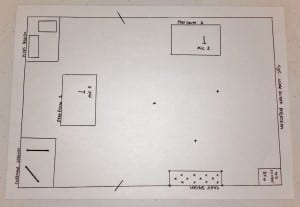After much discussion as a group, I proposed that we go with the original idea of using promenade staging, meaning there is no defined audience space. The staging would cover the whole auditorium, with the audience free to move around the space and choose where to stand. This breaks the traditional barrier between audience and acting space, giving an informal and relaxed atmosphere which was the initial intention of our piece. Take Me By The Tongue manipulates the role of the audience and puts them in a position where they are very much involved with the piece by being a part of the staging that we will use to perform. There will also be parts of the piece that give the audience instructions and will therefore changing the traditional role of ‘spectator’. Often within contemporary theatre the audience is viewed as “a tangibly active creator of the theatrical event.” (Bennett 2013, p.9).
(Drawn and photographed by Libby Soper. Taken: 4 April 2014)
This sketch was drawn by myself with Andy who has now produced mock ups and computerised versions demonstrating the sizes and more accurate dimensions with regards to the LPAC auditorium. With a promenade performance, for aesthetic purposes and for health and safety reasons, both me and Andy decided to restrict the capacity to 90 audience members. Although the LPAC can seat 444 audience members, for the purposes of our performance, we feel it is the right decision to cap it at 90 and use it as a great marketing tool to advertise the urgency to buy a ticket. There is also a chance that if we do completely sell out we will perform it again half an hour after the first performance with another 90 audience members , therefore making more money for the LPAC and having the opportunity to generate a bigger audience.
Work cited:
Bennett, Susan (2013) Theatre Audiences, London: Routledge.

